 |
||
|
||
| ||
 If you look at the color of the card we are examining today you might notice that it is very similar to a blood-red dawn. That is why I decided to make such shots of the Gainward CARDEXpert GeForce3 PowerPack !!!. But let's turn exactly to the card under consideration and the GPU it's based on. Earlier I said that we are gradually examining all peculiarities and nuances of GeForce3 based cards as new models are tested, that is why each new review of a card on this GPU will help you look at this processor from a different point of view. But for today we have studied almost all peculiarities of cards on this processor and of the GeForce3 itself. That is why this material will be a final stage of examining of the GPU GeForce3. Further reviews of video cads on this chipset will be shorter, and there we will touch only advantages/disadvantages of the card under consideration. In this review, apart from examining two video cards we will check whether the GeForce3 depends on the CPU frequency. Gainward company from Taiwan was introduced in one of our latest articles when we reviewed its video card based on the GeForce2 MX400, equipped with a great deal of stuff such as TwinView, VIVO, and a super-fast memory. Its high-end solutions - NVIDIA GeForce3 based video cards have very long and mouthful names, that is why for this article I have shortened the name to Gainward GeForce3. For the last two months the prices for GeForce3-cards have dropped almost by $100. This trend makes for wider spreading of these cards, thus getting the game developers take into consideration such powerful and multifunctional cards. Before examining the cards I should draw your attention to the following articles where you can find the whole theoretical base connected with this GPU:
CardsGainward CARDEXpert GeForce3 PowerPack !!!The Gainward CARDEXpert GeForce3 PowerPack !!! has AGP x2/x4 interface, 64 MBytes DDR SDRAM memory located in 8 chips on the right side of the PCB.  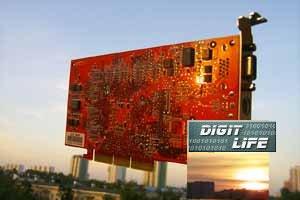 EliteMT produces memory chips with 3.8 ns access time, which corresponds to 260 (520) MHz. Like all other GPU GeForce3 cards, this one works at 200/230 (460) MHz. Unfortunately, I couldn't find out the marking of the memory modules because of deadly glued heatsinks. But there is no necessity in it since all memory modules for such cards come together with the GPU from NVIDIA, that is why memory is the same on all GeForce3 cards. 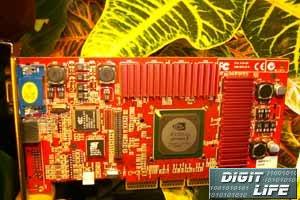 The card's design follows the reference one from NVIDIA, which we have already seen on earlier examined models on this GPU. The card is equipped with a roundish cooler typical of ASUSTeK, with a name of the company shining on it. The heatsink of the cooler is attached with the help of clips, that is why you can remove it to take a look at the chip. 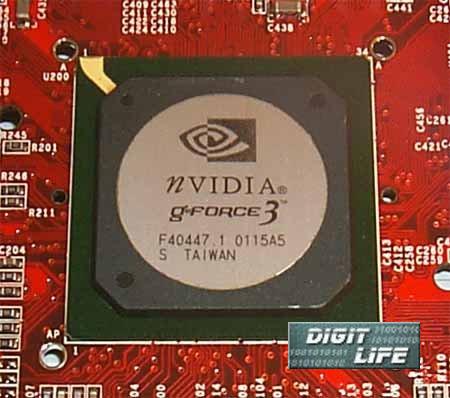 As you can see, the A05 stepping chip was produced at the 15th week of this year. Unfortunately, the layer between the cooler and the GPU doesn't conduct heat effectively. 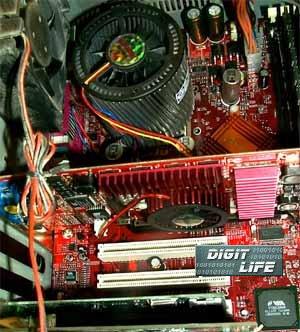 This sample isn't equipped with the DVI-interface, while the TV-out is provided (S-Video connector plus an S-Video-to-RCA adapter). Gainward CARDEXpert GeForce3 PowerPack !!! VIVOThe Gainward CARDEXpert GeForce3 PowerPack !!! VIVO is very similar to the previous one.  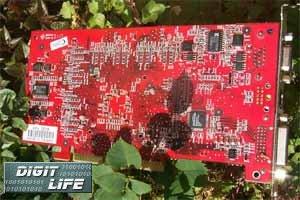 The only difference consists in a daughter card and a DVI connector for monitors with a digital interface. 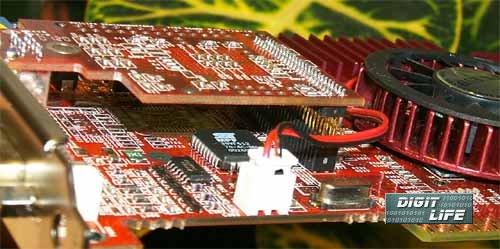 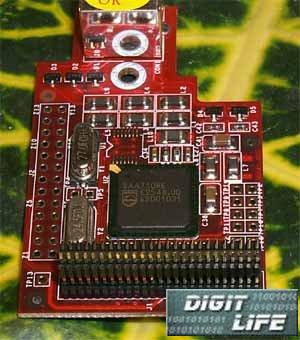 This card contains multimedia functions. Till recently it was only ASUSTeK who produced (or has been producing) the Deluxe series of gaming video cards equipped such functions as analog signal reception with the following sampling, as well as displaying of an image on a TV screen. Besides, the support of stereo-glasses is provided. The Gainward card doesn't support them, but it has a complete support of VideoIn-VideoOut (VIVO). The doughter card has a DAC-ADC module Philips 7100, which controls conversion of an analog signal into digital and back. I described the principle of operation of such VIVO in the review of Gainward CARDEXpert GeForce2 MX400 Golden Sample VIVO. The card ships with a special adapter-splitter meant for realization of multimedia functions. The VideoIn operates with the Ulead Video Studio 5.0SE packet supplied with the card. The realization of the VIVO in the Gainward GeForce3 doesn't differ from that in the above mentioned card. It must be noted, though, that the sampling quality depends on the quality of an adapter. But today the highest-quality VIVO modules equip ATI RADEON cards, while new TV-in/out products based on the Philips processor need much improvement yet. The NVIDIA drivers do not work correctly with the TV-out based on the Philips' codec. At the attempt to display an image on a TV screen, the signal goes back to the monitor. I don't know when this error will be corrected. Both cards ship in Retail packages differing only in a sticker VIVO. 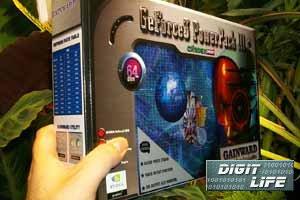 The box contains:
OverclockingBoth cards perform equally during overclocking - up to 240/270 (540) MHz. For today it is an average result among all GeForce3 based cards. It should be noted also that additional cooling must be provided during overclocking of the system. We have removed a layer pad glued to the bottom of the heatsink which just prevented normal cooling. With the layer pad the chip worked at 225 MHz, and when we replaced it with the thermo paste the system managed to reach 240 MHz. Installation and driversTest system configuration:
For testing we used drivers from NVIDIA of 12.60 version, VSync was off. For comparative analyses the results of the following cards are given:
The card is supplied together with NVIDIA drivers v12.10, settings of which allow for adjusting the majority of necessary functions. But for advanced users I would recommend to enable some more functions with the RivaTuner by Aleksei Nikolaychuk, which I have written about in the ASUS AGP-V8200 Deluxe review. Besides, the complete set includes a utility EXPERTool for a more flexible adjustment of 2D and overclocking of the card. I have already written about this program in the review of Gainward CARDEXpert GeForce2 MX400 Golden Sample VIVO. Test resultsThe Gainward GeForce3 has excellent 2D quality. I.e. in 1600X1200 resolution at 75 and even 85 Hz one can work comfortably with a large monitor. You should take into account, however, that 2D quality greatly depends on a definite sample and on possibilities of the monitor. For estimation of 3D quality we used id Software Quake3 v.1.17 - a game-test which demonstrates the card's operation in OpenGL with usage of a standard demo-benchmark demo002. Taking into account that both cards are identical in the 3D graphics, the diagrams contain the results of only one of them. Quake3 Arenademo002, standard modesThe tests were carried out in two modes: Fast (16-bit color) and High Quality (32-bit color). 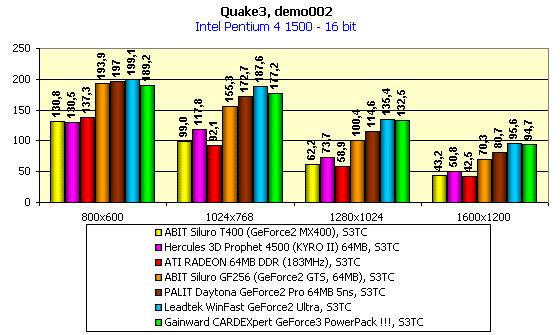 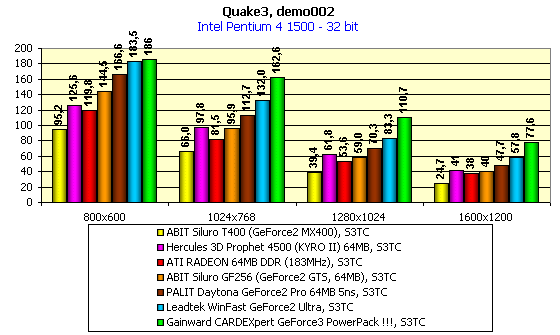 With these tests we just showed that the Gainward GeForce3 corresponds to its level and offers excellent speed in 3D, first of all in 32-bit color. demo002, highest qualityThe tests were carried out in two modes: 16 and 32 bit at the highest quality (detailing levels of the geometry and textures are the highest). 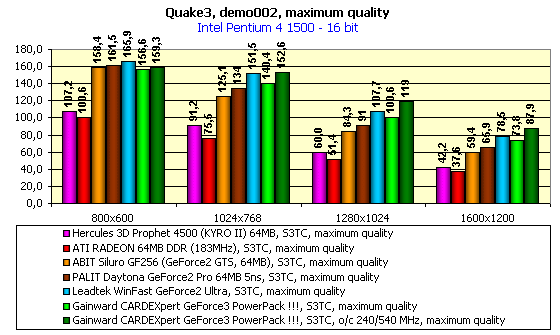 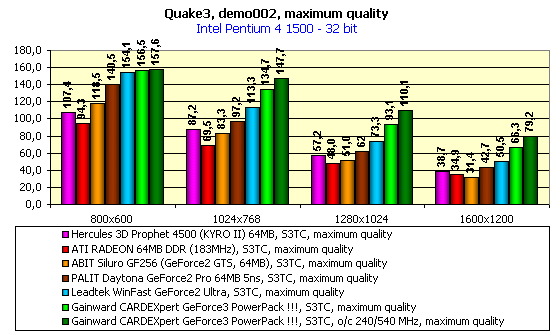 As the load on the accelerator grows, the relative efficiency of the GeForce3 becomes more intensive. demo002, scalabilityThe tests were carried out in two modes: Fast (16-bit color) and High Quality (32-bit color). 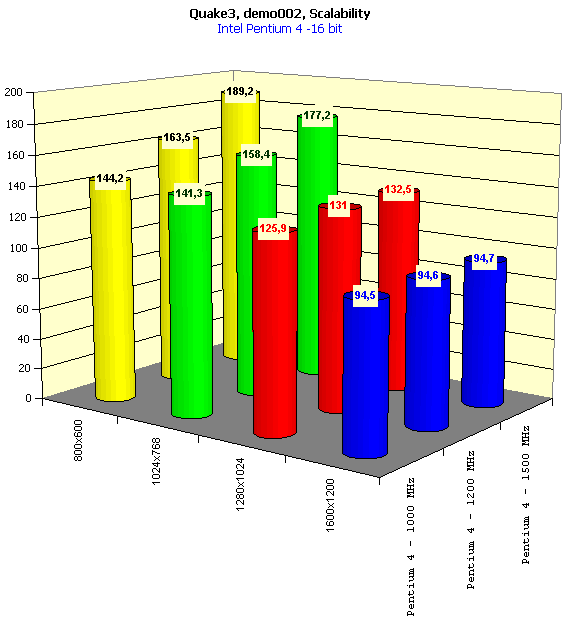 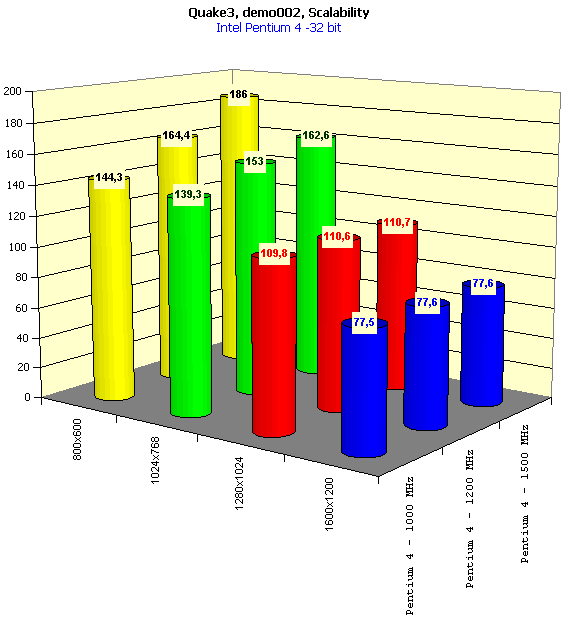 This tests show how the performance of the 3D accelerator depends on the CPU frequency (or Scalability). In this case I used the same processor which can change the multiplier, that is why we could obtain 1000, 1200 and 1500 MHz. The frequencies of the bus and of the memory remained the same (100X4 MHz and 400X2 MHz, respectively). In high resolutions (1280X1024 and higher) the performance doesn't depend on the CPU frequency, i.e. it doesn't matter what you buy: a 1000 MHz CPU (of course, if such Pentium4 had been produced) or a 1500 MHz one - it doesn't affect the performance of the GeForce3 in high resolutions. The 1280X1024 resolution can also be called typical of the level of such cards. For more detailed information about the performance of GeForce3 cards on different platforms refer to our 3Digest. DVDThe WinDVD player uses all the possibilities of the GeForce card to the maximum, starting from the GeForce256. That is why it is very beneficial to use this player for watching DVD movies with MPEG2 software decoding. The CPU utilization didn't exceed 22% in our tests. ConclusionWe have examined two video cards, or rather two modifications of one card Gainward CARDEXpert GeForce3 PowerPack !!!, which differ only in the presence of VIVO. As for the functionality of the GeForce3, there are no differences from the reference card: both demonstrate full correspondence to the specifications of the GPU GeForce3. As compared with its competitors the models have a lower price (except only the revision with the VIVO). The quality of the products is also excellent. And of course an attractive color of the PCB... Today GF3 based cards priced at $350 are not yet affordable for every user. But I hope that the trend of price-cutting will keep, and in autumn the stores will offer a wide range of such cards in the $300 range. The complete characteristics of video cards of this and other classes can be find in our 3Digest. Highs:
Lows:
Write a comment below. No registration needed!
|
|
Platform · Video · Multimedia · Mobile · Other || About us & Privacy policy · Twitter · Facebook
Copyright © Byrds Research & Publishing, Ltd., 1997–2011. All rights reserved.